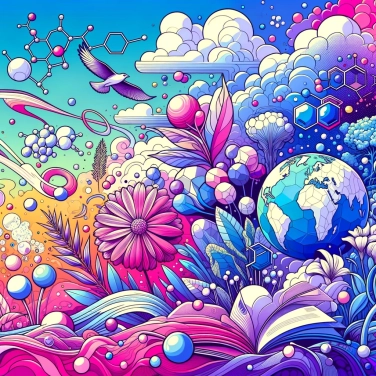The sea is blue because it absorbs the warm colors of the light spectrum and mainly reflects blues and greens.

The sun emits white light, which combines all visible colors. When this light hits water, each color reacts differently. The red, orange, and yellow wavelengths are quickly absorbed, while blue, with its shorter wavelength, penetrates further and scatters everywhere. This phenomenon is called Rayleigh scattering, and it is primarily responsible for giving the sea its beautiful bluish tint. The deeper and purer the water, the more intense and profound this blue will be. The blue light then reaches our eyes, giving the oceans their beautiful characteristic color that we admire so much.
If the sea often appears blue to us, it’s also partly because it cheats: in reality, it mimics quite a bit of what it sees above it. On a beautiful sunny day, the blue sky sends its color directly to the surface of the water, which acts like a giant mirror, reflecting that hue to our eyes. If the sky becomes cloudy or takes on other colors due to a sunset for example, the water logically changes its palette, taking on shades of gray, orange, or even pink depending on what it receives from the sky. But beware, this reflection of the sky does not explain everything: even under a gray sky, the sea often retains a slight bluish tint due to other mechanisms related to the water itself.
Seawater contains plenty of small particles and microorganisms that affect its color. For example, phytoplankton, these tiny floating algae, sometimes tint the water with shades of green or turquoise depending on their concentration. The same goes for sediments, tiny particles of sand or silt in suspension: they modify the way light is absorbed or scattered, thus transforming the perceived color of the water. The fewer particles or organisms there are, the more transparent and deep blue the water appears, typical of the open sea. Conversely, the more loaded the water is, the more it takes on tones close to green, brown, or even grayish.
Water gradually absorbs the different colors that make up light as you dive deeper. First, red disappears, then orange, followed by yellow, leaving blue and green to dominate the great depths. That's why water appears increasingly blue as you look toward the ocean floor. The nature of the seabed also influences this color: a light-colored seabed, covered with white sand for example, reflects more light, thereby enhancing the turquoise or light blue tone often seen near tropical islands. Conversely, a dark seabed absorbs more light, giving the sea a deep or even dark blue hue.
The sky turns red-orange at sunset due to a phenomenon known as 'Rayleigh scattering,' caused by the longer path of sunlight through the atmosphere. This same phenomenon indirectly explains why the sky and the sea appear blue during the day.
Some glaciers and glacial lakes have a vibrant turquoise hue. This phenomenon, reminiscent of the color of the sea, is explained by the ultrafine rock particles suspended in the water, resulting from glacial erosion.
"Marine bioluminescence" is a fascinating phenomenon caused by certain microscopic marine organisms: they emit light when disturbed, creating a bright blue-green shimmer that is especially visible at night.
According to the depth and light penetration, some marine creatures adapt their pigmentation. For example, many fish living in the deep sea display red colors, which are invisible in their natural habitat since red light does not penetrate deeply.
The reflection of the sky on the water does indeed contribute to the blue appearance of the sea, primarily at the surface and under certain weather conditions. However, the main cause of the blue color lies in the way water absorbs and scatters different wavelengths of visible light, especially in the blue hues.
The difference essentially comes from the quantity and depth of water considered. A small amount of water (like in a bottle) appears transparent because its selective absorption of blue light is imperceptible at a thin thickness. It is only in large and deep volumes, such as oceans, that the cumulative effect of light absorption and scattering becomes evident and gives a visible blue color.
The color of the sea depends on several factors, such as its depth, the presence of suspended particles, the nature of the seabed, and the types of marine organisms found there. These elements alter the way light interacts with the water, resulting in different shades: dark blue, turquoise, green, or even gray.
Sure! Here’s the translation: "Yes, pollution can strongly influence the apparent hue of the sea. Waste, hydrocarbons, or algal blooms caused by pollutants alter the light interaction within the water, sometimes resulting in unusual colors such as brownish, reddish, or even the presence of oil-like patches."
A gray or green sea generally indicates the abundant presence of mineral or organic particles in the water, such as algae, plankton, or suspended sand. These elements scatter light differently, bringing out green or dull hues rather than an intense blue.

No one has answered this quiz yet, be the first!' :-)
Question 1/5